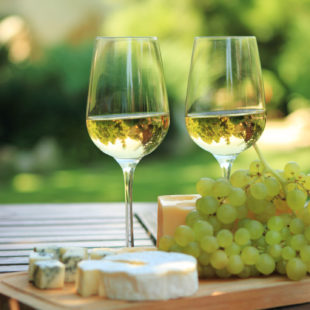Wine is usually made from one or more varieties of the European species Vitis vinifera, such as Pinot noir, Chardonnay, Cabernet Sauvignon, Gamay and Merlot. When one of these varieties is used as the predominant grape (usually defined by law as minimums of 75% to 85%), the result is a „varietal“ as opposed to a „blended“ wine. Blended wines are not considered inferior to varietal wines, rather they are a different style of winemaking; some of the world’s most highly regarded wines, from regions like Bordeaux and the Rhone Valley, are blended from different grape varieties. Wine can also be made from other species of grape or from hybrids, created by the genetic crossing of two species. V. labrusca (of which the Concord grape is a cultivar), V. aestivalis, V. ruprestris, V. rotundifolia and V. riparia are native North American grapes usually grown to eat fresh or for grape juice, jam, or jelly, and only occasionally made into wine.
Hybridization is different from grafting. Most of the world’s vineyards are planted with European V. vinifera vines that have been grafted onto North American species‘ rootstock, a common practice due to their resistance to phylloxera, a root louse that eventually kills the vine. In the late 19th century, most of Europe’s vineyards (excluding some of the driest in the south) were devastated by the infestation, leading to widespread vine deaths and eventual replanting.
Grafting is done in every wine-producing region in the world except in Argentina, the Canary Islands and Chile—the only places not yet exposed to the insect. In the context of wine production, terroir is a concept that encompasses the varieties of grapes used, elevation and shape of the vineyard, type and chemistry of soil, climate and seasonal conditions, and the local yeast cultures. The range of possible combinations of these factors can result in great differences among wines, influencing the fermentation, finishing, and aging processes as well.
Many wineries use growing and production methods that preserve or accentuate the aroma and taste influences of their unique terroir. However, flavor differences are less desirable for producers of mass-market table wine or other cheaper wines, where consistency takes precedence. Such producers try to minimize differences in sources of grapes through production techniques such as micro-oxygenation, tannin filtration, cross-flow filtration, thin-film evaporation, and spinning cones. Regulations govern the classification and sale of wine in many regions of the world. European wines tend to be classified by region (e.g. Bordeaux, Rioja and Chianti), while non-European wines are most often classified by grape (e.g. Pinot noir and Merlot). Market recognition of particular regions has recently been leading to their increased prominence on non-European wine labels. Examples of recognized non-European locales include Napa Valley, Santa Clara Valley and Sonoma Valley in California; Willamette Valley in Oregon; Columbia Valley in Washington; Barossa Valley in South Australia and Hunter Valley in New South Wales; Luján de Cuyo in Argentina; Central Valley in Chile; Vale dos Vinhedos in Brazil; Hawke’s Bay and Marlborough in New Zealand; and Okanagan Valley and Niagara Peninsula in Canada.


